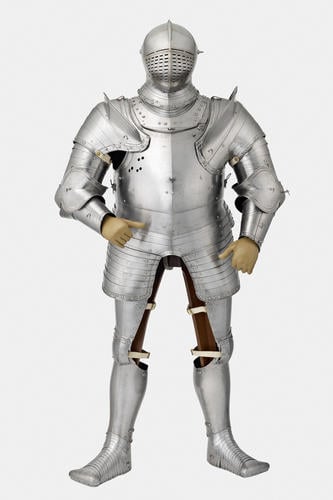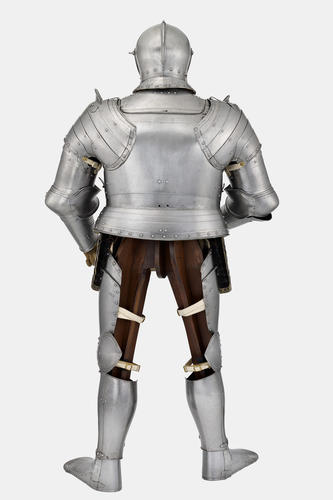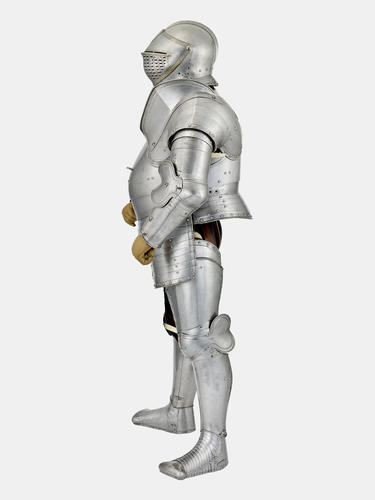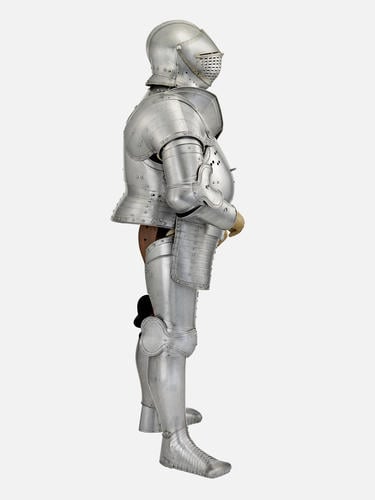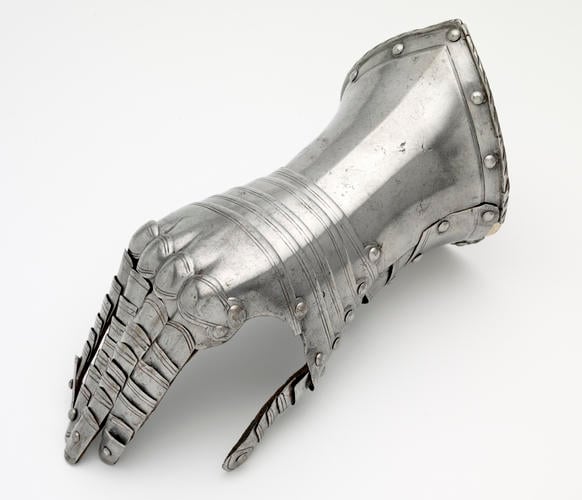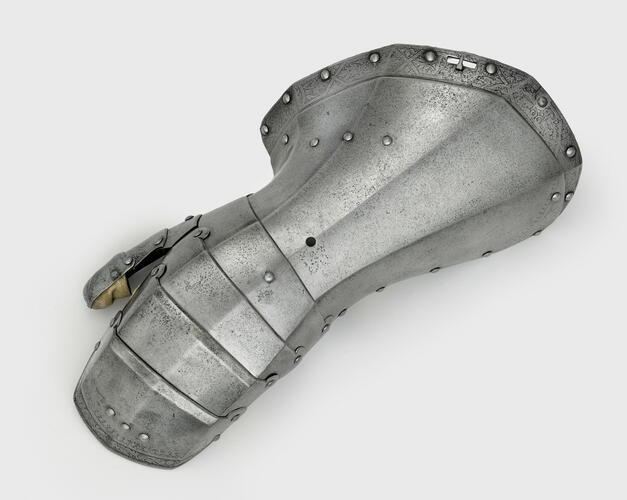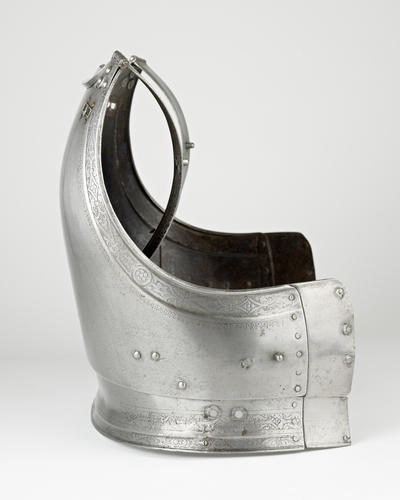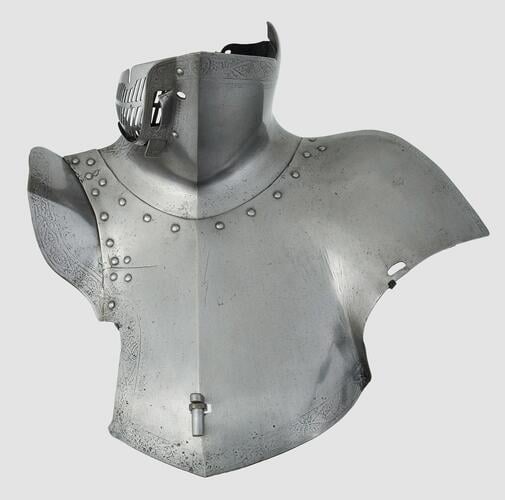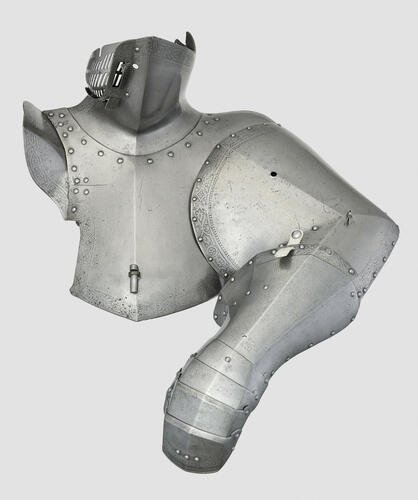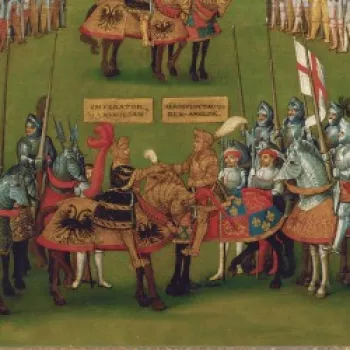Armour garniture of Henry VIII for the field and tilt probably about 1540
Low and medium carbon steel, gold, leather. | RCIN 72834
-
An armour garniture for the field and tilt consisting of a close helmet with integral gorget-plates and a fall (and originally also a falling buff), a gorget, a breastplate with skirt and tassets permanently attached, a backplate, a culet, complete legharness, asymmetrical pauldrons with removable haute-pieces, complete vambraces (the left one both for field and tilt), a grandguard, a pasguard and a manifer (the last three for the tilt).
To allow for the King's increasing girth, the backplate of the armour has been extended by 5.1 cm at either side by the addition of plain plate secured with rivets. Cylindrical studs under the arms designed to receive the hasp projecting from the breastplate have also been adjusted twice: by about 2.2 cm on the first occasion, and a further 3.2 cm on the second.
Tests undertaken on the lowest lame of the right pauldron, the third lame of the left pauldron, the left vambrace and the rear plate of the left greave of the armour show them to have microhardnesses in the ranges 279–308 VPH (average 293 VPH), 223–292 (average 266 VPH), 172–277 VPH (average 249 VPH) and 250–301 VPH (average 277 VPH) respectively. The left greave, the left pauldron, the grandguard and the pasguard are all formed of medium carbon steels that have not been quenched to harden them, at least not successfully. The metal of the right pauldron includes in its composition some irresolvable carbides. Its increased hardness suggests that an attempt was made to quench it. The skull and uppermost lame of the left vambrace contain microconstituents which are definitely the result of a quenching, if not necessarily a full quench.
Text adapted from Norman, A.V.B, & Eaves, I. 2016. Arms and Armour in the Collection of Her Majesty The Queen: European Armour, London.
Metallurgy by Williams, A, & Metcalf, S. 2016. Summary of the metallurgy of European Armour in the Royal Collection. London. Appendix II of Norman & Eaves
Measurements: Helmet: height 29.1 cm, width including pivots 24.1 cm, depth with associated visor 31.6 cm, width of gorget-plates 25.4 cm; Fall: length 24.6 cm, width 21.9 cm; Gorget: height 16.8 cm, width 38.4 cm, internal diameter of the neck-opening 19.1 cm; Front of Cuirass: height from shoulder to lower edge of main plate 33.7 cm, height from centre of neck to lower edge of plate 36.9 cm, height from shoulder to lower edge of waist-lame 39.7 cm, height from centre of neck to lower edge of waist-lame 44.2 cm, width beneath arm-openings 43.3 cm, width at waist 43.2 cm, height from right shoulder to lower edge of right tasset 67.0 cm, height from left shoulder to lower edge of left tasset 68.3 cm; Backplate: height from shoulder to lower edge of plate 33.0 cm, height from centre of neck to lower edge of plate 32.1 cm, height of shoulder to lower edge of waist-flange 39.6 cm, height from neck-opening to lower edge of waist-flange 39.6 cm, width beneath arm-openings 46.1 cm; Culet: height 11.1 cm, width 52.1 cm; Right Pauldron: height 25.7 cm, width 25.4 cm; Left Pauldron: height 16.2 cm, width 32.1 cm; Right Haute-Piece: height 16.2 cm, width 32.1 cm; Left Haute-Piece: height 21.3 cm, width 35.6 cm; Right Vambrace: length 55.3 cm; Left Vambrace: length 55.6 cm; Right Cuisse without Poleyn: height 37.7 cm, width 24.3 cm; Left Cuisse without Poleyn: height 37.9 cm, width 24.6 cm; Polyens: height of each knee-cap 12.4 cm, height of each 15.3 cm; Right Greave: height 37.5 cm, width 13.5 cm; Left Greave: height 35.6 cm, width 15.3 cm; Right Sabaton: height 19.4 cm, length of original part 25.4 cm, width of toe-cap 14.5 cm; Left Sabaton: height 19.4 cm, length of original part 26.1 cm, width of toe-cap 14.9 cm; Grandguard: height 58.6 cm, width 60.5 cm; Pasguard: height 39.2 cm, width 38.8 cm; Manifer: length 46.4 cm, width 22.6 cm.
Weights: Helmet without associated visor: 3.175 kg; Helmet with associated visor: 4.285 kg; Fall: 0.539 kg; Gorget: 5.59 kg; Front of Cuirass: 6.832 kg; Backplate: 4.252 kg; Culet: 1.106 kg; Right Pauldron: 1.975 kg; Left Pauldron: 1.914 kg; Right Haute-Piece: 0.349 kg; Left Haute-Piece: 0.428 kg; Right Vambrace: 2.25 kg; Left Vambrace: 2.693 kg; Right Cuisse without Poleyn: 1.12 kg; Left Cuisse without Poleyn: 1.114 kg; Right Poleyn: 0.480 kg; Left Poleyn: 0.509; Right Greave: 1.025kg; Left Greave: 0.992 kg; Right Sabaton with Heel-Plate: 1.191 kg; Left Sabaton with Heel-Plate: 1.219 kg; Grandguard: 5.698 kg; Pasguard: 2.381 kg; Manifer: 1.89 kg.Provenance
Two tournaments were held by Henry VIII in the latter part of his reign, and this armour may have been made in preparation for one or other of these tilts. The first was held on 11 January 1540, to celebrate the King’s short-lived marriage to Anne of Cleves, and the second for the May Day tournaments of 1540 which took place over four days and included tilts, tourneys and foot combats over the barrier.
The armourer Erasmus Kyrkenar (or Kirkener), a man of presumed German origin, is first recorded in an English royal bill of 10 February 1518. On 5 November 1519 he was appointed armourer for the King’s body at an annual salary of £10. By 1539 he had replaced Martin van Royne as Master Workman in charge of the royal workshops at Greenwich, although van Royne stayed on a higher salary, perhaps as a consultant. The period of Kyrkenar’s mastership was probably the most innovative in the life of the Greenwich workshops. He died at Greenwich in 1567, and was succeeded by John Kelke.
The armour was transferred from the Tower Armouries to Windsor Castle by command of King George V in 1914. The grandguard and pasguard, which were held separately at the Tower, followed in 1956, as did the fall in 1957.
The helmet has been converted into a visored close helmet, for purposes of display, by the removal of its fall and the addition of a visor from Henry VIII’s Greenwich garniture of 1540. -
Creator(s)
(nationality)Acquirer(s)
-
Medium and techniques
Low and medium carbon steel, gold, leather.
Category
Object type(s)
Place of Production
Greenwich [London]





